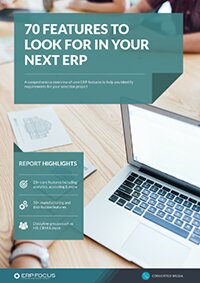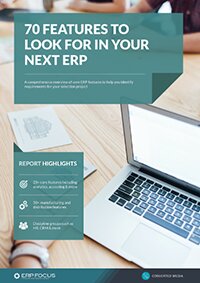Three underrated ERP features and why you should use them
ERP features include a powerful set of tools that can help almost any business by providing needed information and guiding people to make desirable choices in their work. Some of these are underrated in their utility.
1. Basic configuration setup
Customers, suppliers, parts, and operations are just a few of the building blocks in any ERP and each of these blocks has many configurations to select from. Too often these ERP features are underrated. Maybe once the system is implemented, these are forgotten but situations change and these can be reset to cause the system to behave properly. Every order from a customer has a delivery method expected by the customer.
ERP includes a field called “ship via” or some similar title. These can be as simple as UPS ground. They can also be complex to include a selection tree process where up to a certain value or weight the method is one way and over that another way is desired. When properly set, the correct method is automatically chosen at the creation of an order and there is no concern that a temporary shipping clerk filling in for a day might ship the wrong way and cause a problem for your customer.
2. Alternate routing
This is another optional ERP feature that is severely underrated. All products are manufactured through a series of machine and manual operations. The machine chosen will be the one best suited for an operation on that product. What happens when that machine is being repaired one day? What happens when that machine is being used for another product?
This ERP features guide outlines all the must-have features for your next software purchase
Alternate routings can select another machine or manual process that can be used. When the usual machine is in repair there is no choice and the overall process might take longer but the process can still be planned to complete on time. When capacity is the issue, ERP can help determine which order should have priority on that machine and how to best process the lower priority order.
3. HCM utilization
Today’s ERP systems include human capital management modules that too often are only used to record employee’s names and tax ID. But why stop there? That same module can also track training and certifications for workers. If a particular certification is needed for an operation, ERP can limit the people allowed to log on that operation to only those with that certification. Maybe someone with unique capabilities is aging and might retire someday soon. HCM can help identify current employees who could be trained to take over with no delay when that retirement arises.
Look carefully into your ERP. Are you getting all the value you can from it?
Free white paper

70 features to look for in your next ERP
A comprehensive guide to help you identify requirements for your ERP selection

Featured white papers
-

70 features to look for in your next ERP
A comprehensive guide to help you identify requirements for your ERP selection
Download
Related articles
-

Nine signs you need an eCommerce ERP integration
A guest blog from Brightpearl discussing eCommerce ERP and integration
-

Secret KPI: Why Your ERP Implementation Team Matters More Than Software
Learn how Godlan ensures successful ERP implementation for manufacturers with proven strategies &...
-

Top 10 ERP selection criteria (including checklist)
The most important ERP selection criteria you should keep in mind during your selection process.

